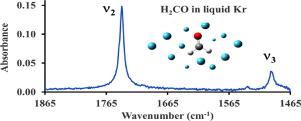Journal of Quantitative Spectroscopy and Radiative Transfer ( IF 2.3 ) Pub Date : 2022-06-18 , DOI: 10.1016/j.jqsrt.2022.108299 Suresh Sunuwar , Helena Diez-y-Riega , Carlos E. Manzanares

|
The infrared spectra of formaldehyde (H2CO) dissolved in liquid krypton between 125 K and 137 K have been obtained using a Fourier transform infrared spectrophotometer and a low temperature cryostat. Backing pressures higher than 1.5 atm were necessary to liquefy Kr above 120 K. Monomeric formaldehyde in gas phase was prepared by thermal decomposition of para-formaldehyde. Peak positions (ν), wavenumber shifts between the gas and liquid solution spectra (Δν), and full widths at half maximum (fwhm) are reported. The H2CO vibrational frequencies in liquid Kr are slightly lower than the gas phase frequencies at room temperature because of the inertness of the solvent. The Gaussian 16 software package is used to determine the geometry and lowest energy of H2CO at room temperature and at the temperature of the experiment. Fundamental harmonic and anharmonic vibrational frequencies and relative intensities are calculated. The influence of the solvent on fundamental vibrational frequencies is studied using the polarizable continuum model (PCM). When used in conjunction with calculated anharmonic frequencies, the PCM model shows qualitative agreement with experimental frequency shifts and relative intensities in liquid Kr. The presence of H2CO in space is discussed in reference to the ν1 and ν5 absorption bands observed in comets, the ν1 and ν2 absorptions in interstellar clouds, and the lack of detection of the ν4 and ν6 bands of H2CO in the atmosphere of Titan. The carbonyl stretching mode ν2 is suggested as a possible candidate for confirmation and identification of H2CO in space due to its larger strength in comparison to the other modes that have been studied at low temperatures and its characteristic frequency that is completely removed from CO2, CO, H2O and CH3OH vibrational modes.
中文翻译:

甲醛在低温下溶解在液态氪中的红外波段以及彗星和星际云中 H2CO 的振动模式 ν1、ν2 和 ν5
使用傅里叶变换红外分光光度计和低温低温恒温器获得了溶解在 125 K 和 137 K 之间的液态氪中的甲醛 (H 2 CO) 的红外光谱。高于 1.5 atm 的背压对于在 120 K 以上液化 Kr 是必要的。气相中的单体甲醛通过多聚甲醛的热分解制备。报告了峰位置 (ν)、气体和液体溶液光谱之间的波数偏移 (Δν) 和半峰全宽 (fwhm)。由于溶剂的惰性,液态 Kr 中的 H 2 CO 振动频率略低于室温下的气相频率。Gaussian 16软件包用于确定H 2的几何形状和最低能量CO在室温和实验温度下。计算基本谐波和非谐波振动频率和相对强度。使用极化连续模型 (PCM) 研究了溶剂对基本振动频率的影响。当与计算的非谐波频率结合使用时,PCM 模型显示出与液体 Kr 中的实验频移和相对强度的定性一致。参考彗星中观察到的ν 1和ν 5吸收带,星际云中的ν 1和ν 2吸收,以及未检测到ν 4和ν 6来讨论空间中H 2 CO的存在土卫六大气中的 H 2 CO波段。羰基拉伸模式 ν 2被认为是空间中确认和识别 H 2 CO 的可能候选者,因为它与已在低温下研究的其他模式相比具有更大的强度,并且其特征频率完全从 CO 中去除2、CO、H 2 O 和 CH 3 OH 振动模式。











































 京公网安备 11010802027423号
京公网安备 11010802027423号